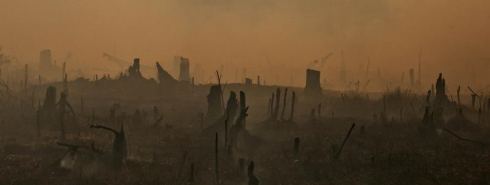Peatlands are found all over the world, come in many forms, display many different characteristics and are used in many different ways. Within the tropics most peatlands are forested, including large tracts in Southeast Asia, Latin America and Central Africa. However peatlands have recently come under increased threats including from overexploitation, deforestation, and fire.
The links between forested peatlands, climate change and REDD+ are already being drawn.
Although peatlands only cover about four million km2, they contain significant carbon stores[1] with each centimetre of peat depth containing about six tons of carbon per hectare[2]. In tropical areas, where most peatlands are forested, about 50,000-70,000 million tons of carbon[3] has been measured. This estimate does not, however, include the newly measured peatlands in Central Africa which are expected to cover 147,000km2 (the size of England) with depths reaching up to six m[4].
The destruction or degradation of forest cover on peatlands delivers a double blow for carbon emissions with losses from both standing biomass and from the drying and degradation of peat soils. Taking the example of the peat fires in Indonesia, smoke from the fires could be seen from outer space and experts believe it to be the worst environmental disaster of the 21st century. During the peak of the fires in October, 2015, carbon emissions from Indonesia’s fires, on some days, exceeded the average daily emissions from the United States[5].
However, carbon emissions aren’t the only consequence of losing peat forests. In the peatlands of Sumatra and Kalimantan, deforestation and drainage clearly increases local flooding and leads to higher flood peaks and lower baseflow. Furthermore, peatlands tend to have very high biodiversity value hosting endangered species such as orangutans and the Sumatran Tiger.
Finally, drained and drying peatlands are exposed to subsidence, which in the case of coastal peatlands can lead to saltwater intrusion with highly damaging effects for agricultural production. For example, subsidence may cause almost the entire area of coastal peatland in Southeast Asia (~250,000 km2) to be lowered to near sea level and become susceptible to frequent or permanent flooding[6].
As such, targeting REDD+ action on forested peatlands can be an effective strategy towards realizing emission reductions and achieving multiple benefits for biodiversity, livelihoods, and human health and well-being.
The UN-REDD Programme is already supporting actions targeting peat including through an assessment of fiscal incentives for Indonesian palm oil production and the mapping of carbon stocks and great ape habitat in key forested peat areas. Furthermore, key commodity producers operating on or near peatlands are being engaged in REDD+ planning and decision making through the cross-cutting priority on stakeholder engagement. Finally, UNEP, in collaboration with a number of partners, is developing a Global Peatlands Initiative to improve the knowledge base on peatlands and their contribution to climate change, and to support sustainable peatland management.
The UN-REDD Programme and its partner countries look to forests for climate change solutions. But the peat lying below the forests is not being forgotten.
[1] Susan Page, John O’Neil Rieley, Christopher Banks. Global and regional importance of the tropical peatland carbon pool. Global Change Biology, Wiley-Blackwell, 2010, 17 (2), pp.798.
[2] http://www.carbonstockstudy.com/hcs-study/soil-carbon
[3] Susan Page, John O’Neil Rieley, Christopher Banks. Global and regional importance of the tropical peatland carbon pool. Global Change Biology, Wiley-Blackwell, 2010, 17 (2), pp.798.
[6] Hooijer et al (2012), Subsidence in Drained Coastal Peatlands in Southeast Asia: Implications for Sustainability. Paper submission presented to the International Peat Society, June 2012

